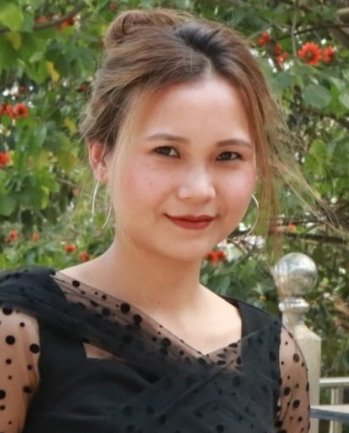— C. Lalmuanpuii
Research Scholar, Dept. of Social Work, MZU
Research Scholar, Dept. of Social Work, MZU

Abstract:
Children with Disabilities (CwDs) are one of the most vulnerable groups in society. It can also be said that CwDs are one of the most marginalized and excluded groups of children. They experience widespread violations of their rights and suffer from various kinds of stigmatization and discrimination as a result of their impairment. CwDs also encounter certain kinds of barriers and challenges because of their disability and utilize different types of coping with strategies in order to overcome the barriers and challenges. This study attempts to highlight information related to the situation of CwDs in Aizawl, Mizoram by examining the challenges faced by Children with disabilities and explore the coping strategies utilized by them.
Introduction
Person with Disability (PwDs) means a person with long term physical, mental, intellectual or sensory impairment which, in interaction with barriers, hinders his full and effective participation in society equally with others. According to the Rights of Persons with Disabilities (RPwD Act, 2016),
The term, Children with Disabilities (CwDs) is used to refer all children up to the age of 18 years who have ‘long-term physical, mental, intellectual, or sensory impairments which in interaction with various barriers may hinder their full and effective participation in society on an equal basis with others’ (Convention on the Rights of Persons with Disabilities, Article 1).
PwDs are one of the most underprivileged and oppressed groups of the society. As stated by Oliver (1996), “disabled people have been mistreated, abused, and disadvantaged on many fronts”. It is also evident that Children with Disabilities often face discrimination not only in terms of service provision but also in the justice system (WHO,2011). Children with disabilities are one of the most marginalized and excluded groups of children, their voices were hardly heard and they were experiencing widespread violations of their rights (UNICEF, 2006). It is noted that in most of the developing countries, there exist little relevant data of Children with Disabilities which made it difficult to recognize the total population of CWDs (WHO, 2011).
It is estimated that more than a billion population in the world are living with disability (WHO, 2011) out of which at least 93 million are children with disability (UNICEF, 2006).
In India, there are 2.68 crore persons living with disability (Census, 2011). Estimate also suggests that 12 million children are living with disabilities in India (Childline, 2010).
In Mizoram, there are 15160 persons living with disabilities out of which 3784 persons belong to the age group 0-19 (Census, 2011).
Review of Literature
The study made by Shumbaa and Abosib (2011) and Tran (2014) found that a female child living with disability are more in number, while Cohen & Prahova (2006) found that boys are more in number. Person with Disabilities do typically lives in poorer households (Mohisini & Gandhi, 1982; Filmer, 2008) and are more likely to belong to broken family (Cohen & Prahova, 2006). The education level of the CwDs is very low and there is also lack of occupational skill training (Mishra & Gupta, 2006).
CwDs often encounter social stigma, discrimination and exclusion because of their disability (Harper and Wecker, 1989; Mishra & Gupta, 2006; Cardona, 2013; Lalvani, 2015). These experiences were not only from other kids but also from professionals including teachers, doctors and those working in the health sector (Shumbaa and Abosib, 2011; Cardona, 2013; Tran, 2014).
CwDs are often being perceived as objects of charity (Cardona, 2013), viewed as odd and different (Scott, 1980), and often experience people’s stares and gaze (Singha and Ghaib, 2009). CwDs, because of their disability, have mobility problem and have difficulty in carrying out certain tasks on their own for which they have high dependency on others (Connors and Stalker, 2007; Sylvestera J. et. al, 2014). Because of their deprivation, CwDs often encounter challenges relating to mental health and are likely to have a feeling of inferiority and depression (Bhatia M.S, 2009) that includes self-pity, feeling of being different from others, uncomfortable feelings, emotional scars and lack of self-confidence (Sen 1988; Singha and Ghaib, 2009; Bhatia M.S, 2009).
CwDs also experience barriers in accessing services that include geographical distances, economic constraint, lack of Transportation, lack of Infrastructure, physical accessibility, lack of trained teacher and lack of disability policy (Klassing 2007; Soorenian, 2013).
The different coping strategies utilized by CwDs includes accepting physical limitations, involving others in their daily activities and being flexible, gaining confidence from previous success, gathering inspiration from role models, receiving encouragements from others, acquiring an optimistic views and by looking for medical breakthroughs (Kowalski & Chung, 2012). Other coping strategies includes learning to live with contradictions, expecting good days, self productive, self active, flexibility, environment productive, environment flexible, being total self, total environment and adaptive behavior (Halmhuber and Paris,1993;Olney & Kim, 2001).
In traditional Mizo society, the disabled were exempted from various community works not because of stigma but because of disability. There are clear indications in customary law that there was some level of understanding towards persons with disabilities.
From earlier times, Mizos had different concepts related to disability namely, ‘piangsual’ (person with physical deformity), ‘ramtuileilo’ (person who is not in a position to carry out work), ‘mi anglo’ (mentally challenged person) and ‘mi â’ (person with mental illness). With emerging awareness of the rights and dignity of persons with disability, more accepted terms like ‘rualbanlo’ (a challenged person) and ‘vohbik’ (a special person) were used for addressing persons with disability. However, in Mizoram, persons with disabilities are still being teased and stigmatized by the society and are regarded as helpless and useless (Chhangte, 2012).
Methodology
The Study was exploratory in design and adopted a mixed method. The study was conducted within Aizawl City. Data were collected from both primary and secondary sources. Primary sources include data collected from Children with Disability and their care givers. Secondary source were collected from Government and Non-Governmental records. A purposive sampling procedure was utilized. Children were identified from Institutional and Non-Institutional settings that catered to children with disabilities in Aizawl. Three types of disability such as hearing impaired, visually impaired and orthopedically handicapped were represented by 20 children each. Overall, the sample size was 60 and includes only Children with Disability between the ages of 11-18 years.
The study used a semi-structured interview schedule as a tool for data collection. Qualitative methods such as Focus Group Discussion and Participatory techniques were also utilized.
Results and Findings
Socio- Demographic Profile
Among the respondents, female respondents are more in number (60%). Majority(75%) of the CwDs belong to stable family. Majority ( 98.3 %) are Christians with maximum numbers (68.3%) of respondents affiliated to Presbyterian denomination. More than half (61.0 %) of the children are from urban areas and higher numbers (63.3%) of the children belong to nuclear family. Children studying in Primary school constitute the highest number (26.7%).More than half of the children’s parents educational level were below higher secondary level. Though many of the children (43%) do not know the economic category of their family, higher number of children (28.3%) belongs to APL family.
Challenges
Table 1 Challenges
| Sl. No. | Challenges | Mean | SD |
|---|---|---|---|
| 1 | Mental Health Problems | 2 | 1 |
| 2 | Stigma and Discrimination | 2 | 1 |
| 3 | Problems in studies | 2 | 1 |
| 4 | Financial problem | 1 | 1 |
| 5 | Mobility problem | 1 | 1 |
| 6 | Dependency of others | 1 | 1 |
| 7 | Poor physical health | 1 | 1 |
| 8 | Lack of trained care-givers | 1 | 1 |
| Average total | 1.4 | 1 |
Source: Computed
Table 1 highlights the challenges faced by the children as a result of their disability. There were 18 challenges which were stated and measured according to 4 point scale 0 to 3 where 0 represents the minimum scale and 3 represents the maximum scale. 0 represented totally disagree, 1 represented disagree, 2 represented agree and 3 represented totally agree. From the table, we find that the children faced multiple challenges.
It can be seen that the challenges faced by the children with disability includes problems relating to mental health which reflects the findings of Sen (1988), Singha and Ghaib (2009) and Bhatia M.S (2009) where they found that CwDs are likely to have a feeling of inferiority and depression that includes self-pity, feeling of being different from others, uncomfortable feelings, emotional scars, uncomfortable feelings and lack of self-confidence . It can also be seen that there prevails stigmatization and discrimination of CwDs in Aizawl which is also evident in the findings of Harper and Wecker (1989), Mishra & Gupta (2006), Chhangte (2012), Cardona (2013) and Lalvani (2015) where they found that CwDs encounter social stigma, discrimination and exclusion. The table also shows that CwDs often encounter problem in studies due to their disability which replicate the findings of Mishra & Gupta, 2006 where they found CwDs are more likely to belong to poorer household.. Other challenges include Financial problem (Mohisini& Gandhi, 1982; Filmer, 2008), Mobility problem and dependency on others others (Connors and Stalker, 2007; Sylvestera J. et. Al, 2014), poor physical health and lack of trained care giver that includes both teachers and parents (Soorenian, 2013).
Coping Strategies
Table 2: Coping Strategies
| Sl. No. | Strategies | Percent |
|---|---|---|
| 1 | Praying | 45.0 |
| 2 | Avoiding others | 36.7 |
| 3 | Playing | 31.7 |
| 4 | Crying | 31.7 |
| 5 | Motivate oneself | 26.7 |
| 6 | Rebellious behaviour | 18.3 |
| 7 | Tell others | 18.3 |
| 8 | Watching TV and listening to music | 13.3 |
| 9 | Teach Sign Languages to others | 13.3 |
| 10 | Read and write | 8.3 |
| 11 | Drop Out | 8.3 |
| 12 | School Absenteeism | 8.3 |
| 13 | Being with someone close | 5.0 |
| 14 | Acceptance | 3.3 |
Source: Computed
Table 18 highlights the different types of Coping Strategies utilized by Children with Disability in order to cope with challenges they faced. From the table it can be seen that the children also had multiple coping strategies. We see that there are 14 types of coping strategies which were utilized by the children. It can be seen from the table that almost half (45%) of the children pray in order to cope with their problems. Among the children, 36.7 per cent avoid being with others while 31.7 per cent play with others so as to cope with their problems. Further, 31 per cent cry and 26.7 per cent of the children motivate themselves to cope with their challenges while some (18.3%) develop rebellious behavior. The other coping strategies include telling others about their experiences and feelings (18.3%), watching television and listening to music (13.3%), teaching sign language to their friends (13.3%), reading books and writing (8.3%), dropping out from school (8.3%), absenteeism in schools (8.3%), being with someone close (5.0%) and accepting role limitations (3.3%).
Accepting role limitations replicate the finding of Kowalski & Chung (2012) where the differently abled accepted their physical limitations and accept their dependency on others. They also accepted and understand the fact that they have to rely more on friends and family for daily activities. It also reflects the findings of Oley & Kim (2001) where Disabled children establish control of themselves and see themselves as having ability.
Focus Group Discussion
A focus group discussion was conducted among children with visual impairment.
The discussion was divided into three main topics viz. Challenges faced in school, challenges faced in community and coping strategies.
i) Challenges faced in School:
Children encounter different kinds of challenges in schools. Though classroom teaching was good, children come across difficulty since they do not have Brail Text Books to review what they have studied and to have a wider concept and also, brail books are very rare to find in different libraries of Mizoram. They also face trouble in writing down the notes because most of their teachers dictate the notes too fast while writing in brail takes a lot of time and also, most of the teachers did not check the notes for them. Sometimes, teachers used to make fun of them which makes them feel uncomfortable to sit in the class.
And also they find difficulty in using the brail dictionary because it is very difficult to search for a word in the dictionary and took quite a lot of time to search for just one word. The children also talk about how troublesome it is to appear in a board exam where they could not give exam in Brail and that they need to have a writer who should write down what they narrate for their exam.
ii) Challenges faced in Community:
Children usually encounter a situation where they were seen as beggars or object of charity. Most of the times, especially in market places, people try to give them money thinking that they were beggars or because they saw them as object of charity. And also in public places children experience conditions where they were being rudely talked to by people. “When we go to public places and accidentally rush to someone, they used to talk rudely saying, “You, blind girl, be careful if you cannot see”, said one participant.
They were also often treated as if they were hearing impaired where people speak to them loudly near their ears and also often hear people talking at their back about their disability as if they were deaf. The children also sometimes encounter situation where children, especially the small ones talk about the disability where the children say, “What happened to his eyes?”, “He/She is blind”, etc.
iii) Coping Strategies
There are certain coping strategies which were being utilized by the children. Since children could not use their eyes to see, they use other methods such as touch, hearing, smell, and memorizing the roads and the pathways of their school or community. In order to prevent situations where people see them as blind beggars or objects of charity, the children often act and walk as if they were not blind and often hesitate to use blind sticks, but this often leads to some small accidents. When small children tease them, they informed the parents of those children about what happened. But, usually the parents did not give good response or importance to it, rather stays on the side of their child and often blames the Visually Impaired child instead. The children often cry when they face difficult circumstances and often hesitate to sit in the class of the teacher who use to make fun of them.
Participatory Technique
A Causal tree analysis was conducted among children with hearing impaired.
From the causal tree analysis, it can be known that there can be different causes of Disability which includes mother physical and mental state of mind during pregnancy, deficiency during mother’s pregnancy, heredity, prolonged labour, induced birth, accidents, poverty, substance abuse and severe sickness. It can also be seen that there are different challenges and problems which were encountered due to Disability. Through the causal tree analysis, we can also acknowledge that there are some parents who were ashamed of their disabled child. And also, it can be seen that Children with disabilities are at high risk of being sexually abused.
The analysis also tells us that CWDs have to highly depend on others. It also tells us that CWDs are often looked as being different, teased and frequently excluded from peers and playmates. Due to the various stigmatization and discrimination, CWDs obtain self pity and started having inferiority complex. We can also understand from the analysis that CWDs often possess rebellious behavior.
The causal tree analysis gave information about lack of services for CWDs. And also there exist great transportation problem and also communication problem especially for Hearing impaired and speech problem. It can also be seen from the causal tree analysis that disability does lead to poverty since their medical treatment cost a lot.
Conclusion
CwDs encounter problems relating to mental health. Therefore it is necessary to establish counseling and therapy centers for CwDs so that they will be able to receive help from professional counselors and therapists. Such kind of services should be made available in institutional and non-institutional settings that provide services for the Disabled. Training and workshops on regards to the care giving of children with disabilities must be organized for those families with disabled child so that children with disabilities would be able to receive family support in an adequate amount
Children with disabilities encounter different kinds of stigmatization and discrimination in the society. And it is very necessary to organize awareness on children with disability so that the perception of the people on children with disability would be changed and thus will provide a better environment for the children with disabilities.
Children spend most of their time in schools and it is in the school that they are likely to be bullied, teased and discriminated for which many CwDs drop out from schools. It is very necessary to take measures so as to place professional counselors in schools so that children with disabilities would be protected from certain kinds of abuse. Schools should also be equipped with necessary educational materials required for teaching children with disabilities, and also the infrastructures of schools must be developed in such a way as to create barrier-free environment for CwDs in schools. It is also necessary to organize special training for teachers so that special teachers for children with disabilities may be available in schools. And also, measures should be taken to reserve seats for children with disability in educational settings.
As for the Blind in particular, Braille books were not available and they do not have Braille text books. Also, they face difficulty in board examinations since Braille examinations were not conducted. Thus, the departments concerned must take measures in order to provide Braille text books and to conduct Braille exam for board examinations.
The findings of the study calls for the formulation and implementation of Policy for CwDs in order to uplift the situation of CwDs and to enjoy freedom and rights.
References:
- Bhatia, M.S. (2009). Special Children; Problems and Solution. New Delhi: National Book Trust, India
- Cardona, G.C. (2013). “Overcoming disabling barriers: disability and attitudes to disability within the Maltese context: an Insider’s Perspective.” Disability & Society, 28 (2), 279–284.doi: 10.1080/09687599.2012.753186
- Chhangte, L. (2012). “Status of Persons with Disability in Mizo Society.” Contemporary Social Scientist, 3(1), 107– 111. ISSN No. 2230-956X
- Cohen, P. & Prahova, M.P. (2006). “Gendered Living Arrangements among Children with Disabilities.” Journal of Marriage and Family, 68 (3), 630-638. Retrieved from http://www.jstor.org/stable/3838881
- Connors, C.& Stalker, K. (2007). “Children’s experiences of disability: Pointers to a Social Model of childhood disability.” Disability & Society, 22 (1), 19– 33.doi:10.1080/09687590601056162
- Filmer, D. (2008). “Disability, Poverty, and Schooling in Developing Countries: Results from 14 Household Surveys.” The World Bank Economic Review, 22(1), 141-163. Retrieved from http://www.jstor.org/stable/40282267
- GOI (2001). Census. Retrieved from https:// pwds.mizoram.gov.in/.
- Halmhuber, N.L. & Paris, S.G (1993). “Perceptions of Competence and Control and the Use of Coping Strategies by Children with Disabilities.” Learning Disability Quarterly, 16(2), 93-111.Retrieved from http://www.jstor.org/stable/1511132
- Harper, D.C., Wacker, D.P. & Cobb, J.C.(1986) “Children’s Social Preferences Toward Peers with Visible Physical Differences.” Journal of Pediatric Psychology,11 (3), 323-341. Retrieved from http://jpepsy.oxfordjournals.org
- Klassing, I. (2007). Disability and Social Exclusions in India. Jaipur: Rawat Publications.
- Kowalski, E. &Chung, K.C.. (2012). “Impairment and disability: Renoir’s Adaptive Coping Strategies against Rheumatoid Arthritis.” American Association for Hand Surgery, 7,357–363. doi: 10.1007/s11552-012-9467- 4.
- Lalvani, P.(2015). “Disability, Stigma and Otherness: Perspectives of Parents and Teachers.” International Journal of Disability, Development and Education, 62(4),379–393. doi: 10.1080/1034912X.2015.1029877
- Ministry of Law and Justice (Legislative Department) (2016). The Rights of Persons With Disabilities Act, 2016. New Delhi: The Controller of Publications.
- Mishra, A. K. &Gupta, R. (2006). “Disability Index: A Measure of Deprivation among Disabled.” Economic and Political Weekly, 41(38), 4026-4029. Retrieved from
- http://www.jstor.org/stable/4418722
- Mohisini, S.R.& Gandhi, P.K (1982). The Physically Handicapped and the Government. New Delhi: Light and Life Publishers.
- Oliver, M. (1996). Understanding Disability: From Theory to Practice. London: MacMillan Press.
- Olney, M.F..&kim, A. (2001). “Beyond Adjustment: integration of cognitive Disabilityinto Identity.” Disability & Society, 16 (4), 563–583.doi: 10.1080/ 09687590120059540
- Sen, A. (1988). Psycho-Social Integration of the handicapped: A challenge to the society. Delhi: MITTAL Publication.
- Shumba, A. &Abosi, O. C. (2011). “The Nature, Extent and Causes of Abuse of Children with Disabilities in Schools in Botswana.” International Journal of Disability, 58 (4), 373–388. doi: 10.1080/1034912X.2011.626664
- Singh, V. &Ghai, A (2009). “Notions of self: lived realities of children with disabilities.” Disability& Society, 24 (2), 129–145.doi: 10.1080/09687590802652363
- Soorenian, A. (2013). “Housing and transport: access issues for disabled international students in British universities.” Disability & Society, 28(8), 1118– 1131.doi: 10.1080/09687599.2012.758033
- Sylvestera, J. ,Donnella, N. , Grayb, K. , Higginsc, K. & Stalker, K. (2014). “A survey of disabled children and young people’s views about their quality of life.” Disability & Society, 29(5), 763–777.doi: 10.1080/ 09687599.2013.848782
- Tran, K.V. (2014). “Exploring the experience of children with disabilities at school settings in Vietnam Context.” Tran Springer Plus, 3, 1-11. Retrieved from http://www.springerplus.com/content/3/1/103
- UNICEF (2016). Disabilities. Retrieved from http:// www.unicef.org/disabilities/
- WHO (2011). World Report on disability. Retrieved from http://www.who.int/disabilities/world_report/2011/report
Cite the original source:
Lalmuanpuii, C and Pachuau, Henry Zodinliana. “Challenges and Coping Strategies of Children with Disabilities in Aizawl, Mizoram.” Mizo Studies, IX, no. 1, Mar. 2020, pp. 106–120.
Lalmuanpuii, C and Pachuau, Henry Zodinliana. “Challenges and Coping Strategies of Children with Disabilities in Aizawl, Mizoram.” Mizo Studies, IX, no. 1, Mar. 2020, pp. 106–120.
![]()







